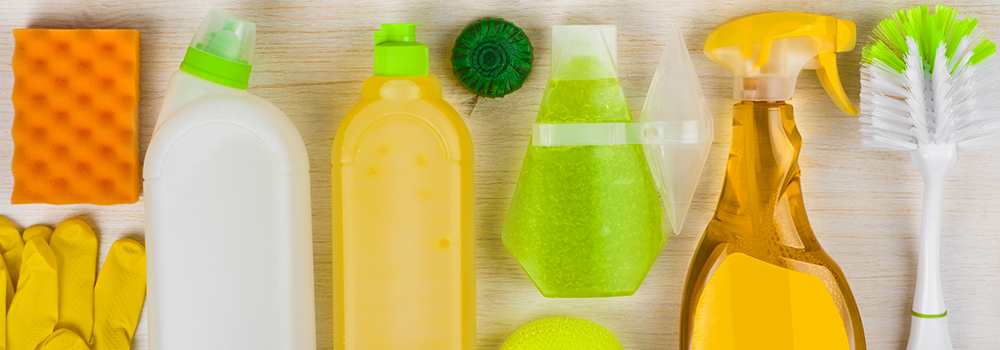Is spring cleaning on your agenda this April? You might be asking, “Who has time for that?” or “Is that even a thing anymore?”
Even if you do not perform the traditional spring cleaning ritual, you may want to consider paying closer attention to the following places when cleaning year round.
Contaminants in the Kitchen
What makes some spots in your kitchen particularly germy? Dark, damp environments are the perfect breeding ground for microorganisms. Some of these microorganisms, including Salmonella, Listeria, E. coli, and certain yeasts and molds, are known to cause illness. These strains can be lurking in locations usually neglected by day-to-day cleaning.
Refrigerator Water and Ice Dispensers: These appliances can provide a convenient source of chilled water and ice cubes, but they can also be loaded with bacteria. Water dispensers and ice makers provide the perfect habitat for mold and other fungi because of the constant presence of moisture at the spout and in the tubing. While usually not harmful to your health, these microorganisms are unattractive, can affect your water quality and be difficult to remove if unattended.
What can you do? Even though this is a task that people often overlook or avoid, the answer is to clean, clean, clean! First, check your appliance owner’s manual for recommendations. Manufacturers will generally guide you on how (and how often) cleaning should take place. You are on your own if this guidance is not provided, but do not give up! This article gives suggestions on how to clean your water dispenser. Be prepared to use a low level of mechanical skills, a small brush, vinegar and some perseverance!
Refrigerator Vegetable and Meat Compartments: Did you thaw out some meat for dinner last night? Did the package leak or drip in your refrigerator? If there is any question of whether or not drippings from meat could be in your refrigerator, it is a good idea to clean it right away. Raw meat can harbor a multitude of potential pathogens. Make sure to always store raw meat in the bottom drawer just in case it leaks.
Fresh vegetables and fruits can also be the source of a wide variety of potential pathogens. It is good practice to remove the drawers from the refrigerator, wash with hot, soapy water and a clean cloth, rinse well and dry thoroughly with a clean towel at least once a month. Avoid cross-contamination by separating ready-to-eat produce from unwashed produce.
Rubber Spatulas: Check your kitchen drawer. Do you have a two piece spatula with a detachable handle? If you do, listen up! Bits of food can accumulate in the joint if the pieces are not separated when washing (which is what those nasty germs want). When washing always use hot, soapy water, rinse and dry thoroughly before putting the pieces back together.
Blenders: Liquids can seep down into the lower portion of the blender jar during an intense pulse or puree. If you are not diligent and thorough in your cleaning, you will have an unanticipated ‘cultural’ experience on your hands! After each use it is a good idea to completely disassemble the jar by separating the blade and gasket at the bottom from the main container. Next wash all the parts in the dishwasher. If you are hand-washing, use hot, soapy water followed by a good rinse. Always remember to allow the pieces to dry completely prior to reassembly. Follow the same protocol for your food processor.
Knife Blocks: Knife blocks are one of the most overlooked hideouts for microorganisms especially when food residue buildup and moisture are present. To clean a knife block, turn it upside down and shake (or use a can of compressed air) to remove any accumulated debris from slots. Then hand-wash the non-wood blocks in hot, soapy water using a small brush if possible to scour inside each knife slot. Sanitize using a dilute bleach solution. After rinsing, place the block upside down to dry allowing air to get into the slots. Remember – germs like moisture. If you have a wooden knife block, here is an easy alternative: throw it away and consider getting a magnetic knife rack which does not have any tough-to-clean slots.
Electric Can Openers: In order to avoid sticky, gooey build-up, wash the removable cutting apparatus after each use. The build up contains lots of nutrients that would suit a microorganism just fine. Be sure to allow it to dry completely before reassembling the unit.
The worst culprit of all: The sponge in your kitchen sink! If you are reading the Microbiologics Blog, chances are you know a little something about microbiology. We should not need to say more than just throw your sponges away!
Pathogens by Air and Water
Furnace Filter: How often do you clean or replace the filter in your HVAC system? Some filters using an electrostatic charge are capable of removing 90% or more of the mold spores, dust and pollen in your home as well as virus and bacterial cells that may be attached to these particulates. It is important to inspect and replace these filters on a routine basis. Cleaner air equals a healthier you!
Humidifiers: You mean the one that has been running all winter? With prolonged use and inadequate cleaning, humidifiers may become a breeding ground for a variety of fungi and bacteria including Legionella. The moisture that lingers on the humidifier filters and inside the water reservoir provides the perfect environment for pathogens. When the humidifier fan runs, it is quite possible that these fungi and bacteria will be expelled into the air you breathe. Be sure to change the water in the reservoir often and consult the user’s manual for cleaning instructions.
Hot Tubs, Pools and Spas: Warm water is a breeding ground for bacteria. Improperly maintained pools, hot tubs and spas can become contaminated with a multitude of harmful bacteria including E. coli, Legionella pneumophila, Pseudomonas aeruginosa, Mycobacterium avium, Streptococcus and Salmonella. Add to this Giardia enteritis, Cryptosporidium, Campylobacter and Naegleria fowleri, and you may have the ingredients for a nice bacteria soup!
Fecal contamination (human and animal) is the leading cause of pathogens in these types of water. However, the contamination can also come from a variety of sources including vomit, sweat, urine and saliva. Swimmers who do not wash their backsides before swimming or after using the bathroom (#2) are unknowingly rinsing off fecal matter in the pool. It is estimated that the average water park facility has several pounds of fecal matter to deal with on a daily basis courtesy of their visitors. Yuck!
Immerse yourself in this nice warm, contaminated water and you may be exposed to pathogens. Absorbing, inhaling or ingesting the water may cause you to be stricken with one (or all) of the following: diarrhea, severe abdominal cramps, fever or vomiting. And do not forget the potential for serous diseases such as infections of the skin, eyes, ears, hair follicles, intestines and urinary tract.
How can you stay healthy? It is vital to keep your hot tub, pool and spa water pH balanced and sanitized, and that you “shock” it regularly. Check the user’s manual for best practices.
Happy Spring Cleaning!
PS: Throw away that old toothbrush, too!






There’s alot of claims here without any scientific literature citations to support them. Not to say they aren’t true but from a company such as yours, lets make sure we are passing along real science.
I usually use Clorox bleach in my dish water and sink to prevent kitchen contaminents
Hot tub,, pools and spas should be maintained and obtain a proper ph level, chlorinate daily and shock when needed. Much easier to treat the water than make someone sick, because the water levels were correctly maintained